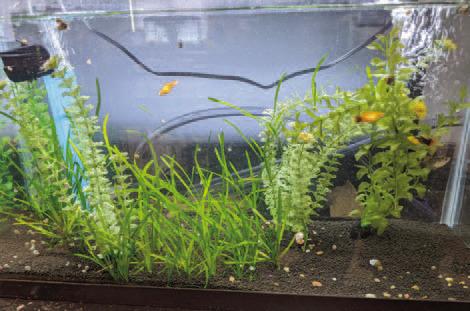When Osceola High School science teacher Andrew Hayes was studying marine biology in college, he never imagined he would one day be a teacher. In fact, when his marine biology professor encouraged him to major in education after seeing him work with kids in a summer program, he told her he would never be a teacher.
“Life changes,” he laughed. “You get a job that is fun but isn’t worthwhile, and you start looking for something else.”
Hayes eventually found his way into the classroom, where he has made a tremendous impact on OHS students interested in marine science.
After starting at Osceola as a biology teacher and teaching a different iteration of the district’s marine science class, Hayes really found his niche during the 2020-21 school year, when he began teaching the current version of marine science, but the groundwork for his unique approach to the course started the year prior.
“Thankfully, we had a pandemic – I think I’m the only person that will ever say that – because I had a lot of time on my hands,” Hayes said. “I’m otherwise very, very busy 11 months of the year but I had a lot of free time on my hands, so I started thinking about ways to improve science within the schools.”
He came up with the idea for his marine science lab to get students more engaged in the learning process, as well as to make a connection with the local ecosystems and environments.
According to one of his grant proposals, Hayes envisioned students using concepts and tools from marine science and biology to identify and evaluate the factors that lead to pollution and its impact on humans and marine organisms. They will breed marine life to determine the impact of different environmental conditions and test potential solutions to the algal bloom problem. At the end of the project, the students will present their findings to local groups like Toho Water Authority.
A project of this size did require a lot of funding, which Hayes secured through an impressive series of grants, the most recent of which was a $2,000 award through the Voya Unsung Heroes program. He was the only winner in the state of Florida.
Hayes said his time as a science undergraduate student helped him understand the grant writing process, because he assisted his professors in preparing documents, but he wasn’t sure how that translated into the field of education. Luckily, he said, a district vendor offered a grant writing program for teachers, which he took advantage of.
“I come up with the budget and find the items we need and from what companies,” he said. “My Excel sheets are long lists of everything, organized and breaking it down to the penny, (and I’m) finding different discounts or reaching out to get quotes. I then send a giant graphic organizer flow chart to the writer, and she spins a web of how to put everything in.”
This process proved fruitful for Hayes, as he has been able to create a marine biology laboratory for his students, consisting of several different tanks of different organisms, both freshwater and saltwater, and most of which are local to Florida.
“We have two touch tanks, both saltwater,” he said. “We have one that has more urchins and will have horseshoe crabs in it so kids can touch different things that they may have never seen before. And then we have a larger touch tank that has sea stars in it.”
The class favorite, and unofficial mascot, is a snowflake moray eel. He is especially popular because of his dog-like personality, where he reacts to the students’ presence and comes up from his normal hiding spot to “beg” for food. Hayes said the eel even acted angry when they came back from the days off for Hurricane Ian.
Now that they’re approaching a full year of having the lab up and running, Hayes and his class are working on improving processes in the classroom and learning what works best. Next up is switching the tanks students are responsible for to give those currently working with freshwater organisms a chance to work with saltwater, and vice versa. “When we do that in January, that transitional period is going to be rough,” Hayes said.
They’re also working to convert a tank from a coral tank to a mangrove tank, after relocating the coral to their guidance office. Having students take care of the growing mangroves and associated organisms ties back to Hayes’ goal of having students work with the Central Florida natural ecosystem. In addition, they’re hoping to expand their touch tanks and continue to work on the aquaculture aspects of the program – they’re currently watching for their clownfish to be developed enough to mate.
Long term, Hayes hopes the district will bring back their Marine Science 2 class, so students who are deeply involved in the lab can take an additional course with him and learn more about the subject. He also hopes to start an after-school club that would allow students to get out into the community and do beach cleanups, work with the fish and wildlife services and learn from industry professionals in both management and aquarist roles.
Despite not meeting his goal of complete student engagement so far (he estimates student engagement is in the 90% range), Hayes said he sees an improvement in how students get involved in class and the lessons they are learning extend well beyond the classroom walls.
“There are very few kids that will sit there the whole time if we’re doing things with the tanks or organisms,” he said. “It teaches the kids not only the job skills of taking care of a tank, it teaches them how they affect their local environment and local ecosystem.”




